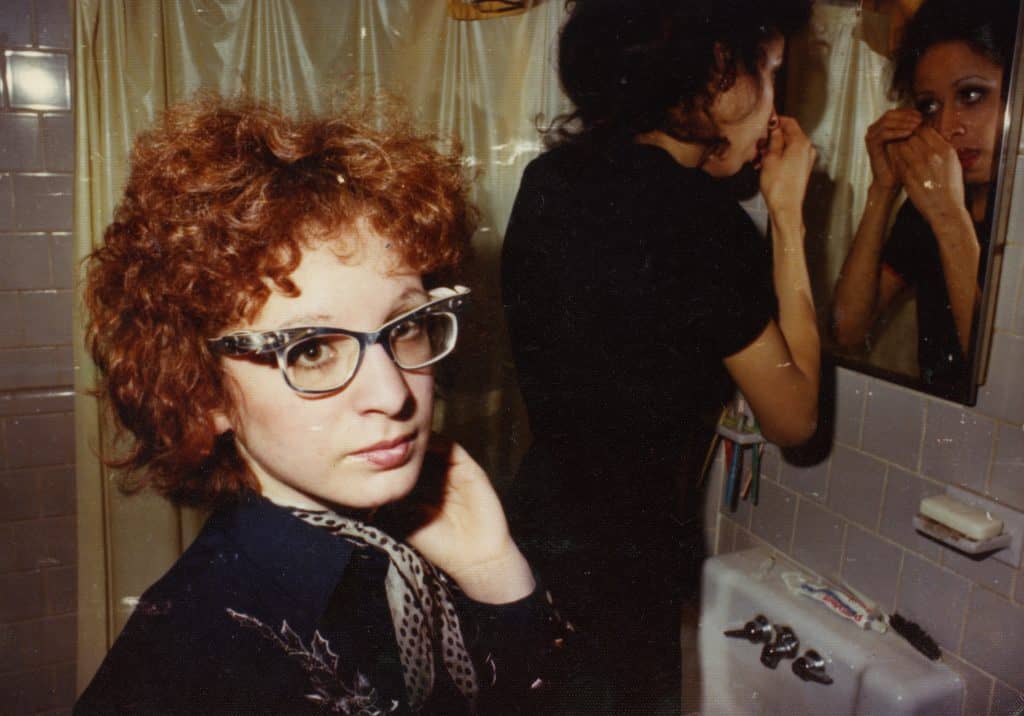The short-term cultural memory of the internet can make entire legacies feel shrouded in the past. Many young people may not be familiar with the undeniable impact of both photographer Nan Goldin and the Sackler pharmaceutical empire, both of which are recontextualized and intertwined in Laura Poitras’ latest documentary, All The Beauty and The Bloodshed.
By the end of the film, anybody unfamiliar with this history will have seared into their brain not only Goldin’s name but her fervent activism for victims of the opioid crisis. Though the film also delves into her history as a visual artist and her experiences within the queer communities of 1980’s New York City, these slideshows pale in comparison to the extremely urgent work she is doing in the modern day.
The film begins with a striking protest at the Metropolitan Museum of Art. Members of Goldin’s advocacy group, Prescription Addiction Intervention Now (P.A.I.N.), begin to crowd around a moat in front of the museum’s Temple of Dendur. The Egyptian exhibit sits in the “Sackler Wing,” making it a perfect spot to make a scene.
As protestors begin to chant (“Sacklers lie, people die!”), hundreds of orange pill bottles are thrown into the water, each with newly printed labels bringing attention to the 200,000 lives lost to addiction and overdose. The Sacklers’ downplaying of the drug’s addictive qualities played a substantial role in the opioid crisis; shortly after this scene, we learn Goldin herself “narrowly escaped” death after battling her own addiction to OxyContin.
Its powerful shows of assertive activism like this, captured with strong verite handheld camerawork, that power Poitras’ portrait. Goldin feels like one of the few public figures that takes no prisoners, actively engaging in the protests (even being arrested following one later in the film) and lending her voice to the cause.

We even see her target museums that house her own work, collections and installations that were instrumental in shaping visual artists’ relationships between themselves and their art. Many credit her as a driving force in several museums cutting ties with the Sackler family (including, eventually, The Met). Despite her humble, dry demeanor, her portrayal in this film is that of a raucous force.
Modern attempts at social upheaval – trying to take down the Goliaths that are the countless corrupt structures and institutions that have marred human existence – can often feel like screams into the void. Goldin’s screams reverberate and shatter; capturing it on film is nothing short of electric. Poitras has found one of the few subjects in maybe all of documentary that can provide a palpable feeling of victory and change.
This isn’t to say there isn’t still injustice; the end of the documentary highlights how Purdue Pharma’s bankruptcy and eventual settlement allowed the Sacklers to largely get off scot free. It’s tragic, especially because what came before captured such raw anger and vengeance.
This is all to compliment only half of the film, however. The film cuts back and forth between these present day sequences and archival recollections of the past. In a candid interview with Poitras laid under slideshows of her own photos, Goldin discusses her fraught family history, exploring her art and sexuality in downtown New York, and her struggle with drug addiction.
For Goldin’s fans and admirers, of which there surely are many, this is as deep of a dive as you can get. However, for those looking from the outside, little is done to make much of this insular history accessible. Goldin’s photos are displayed much like how her exhibitions would be, but mere photos don’t feel like enough active access to justify juxtaposition to her propulsive activism. It often feels like we wade through these history lessons and are jolted back to life when things return to P.A.I.N.

Considering the documentary’s inception, this was inevitable. Goldin and members of P.A.I.N. had already been filming their protests for a documentary more closely centered on the organization. Upon Poitras getting involved, All The Beauty and The Bloodshed became the story of Nan Goldin. Conceptually, it only makes sense, but one has to wonder if a film more closely about P.A.I.N., with one or two sequences refreshing audiences with Goldin’s history, would have been sharper.
This is not to discredit Goldin or her experiences with addiction, rather to say that her experiences in New York and her communities, particularly the strong focus on the AIDS crisis, halts the film in its tracks despite the obvious parallels.
Amidst the uneven structure, Poitras still tells a daring story of resilience and power from the mind of one of our great artists. Goldin admits during the documentary that she is discussing things she has never openly discussed before, yet it all feels like a natural extension of her own sensibilities.
Many of Goldin’s most powerful photographs are those of herself, which include one with a black eye after being beaten by her lover as well as one with a scratched back after having sex. She has never been afraid to expose her life in her art and, as such, Poitras is not afraid to do the same using her own canvas: cinema. All The Beauty and The Bloodshed stands as a monument that is as unflinching in its intimacy as the artist who inspired it.
All The Beauty and The Bloodshed is currently in theaters, courtesy of NEON.
Despite an uneven structure and pace, ‘All The Beauty and The Bloodshed’ is a simultaneously electric and intimate portrait of Nan Goldin and her extraordinary life and times.
-
GVN Rating 7.5
-
User Ratings (0 Votes)
0

Larry Fried is a filmmaker, writer, and podcaster based in New Jersey. He is the host and creator of the podcast “My Favorite Movie is…,” a podcast dedicated to helping filmmakers make somebody’s next favorite movie. He is also the Visual Content Manager for Special Olympics New Jersey, an organization dedicated to competition and training opportunities for athletes with intellectual disabilities across the Garden State.






